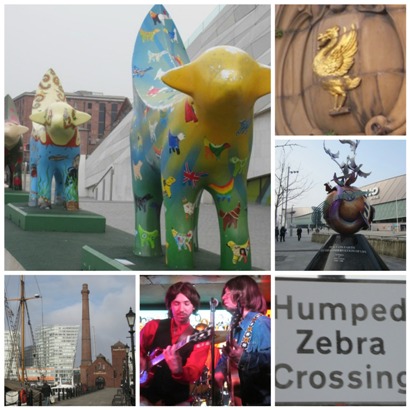|
General Impressions of the Conference
- Membership
- Length: 1 preconference day plus 4 full days
- Attendance: 2,500; their largest ever
- Sessions: Good variety; I tended to go to the Learning
Technologies Special Interest Group (LT SIG) ones. Very nice plenaries,
most of them with a Beatles reference or two; after all, we were in
Liverpool.
Comparison/Contrast From My Perspective
IATEFL is smaller than TESOL, and the conference reflects that.
At around 2,500 attendees, the size was very hospitable. If you stayed
largely within one SIG, as I did, you saw the same people in the
audience repeatedly. I quickly felt at home there, especially after
attending the preconference session.
The preconference was an all-day series of lectures by
different CALL specialists, both from the United Kingdom and from
elsewhere in the world. It was broader and more comprehensive coverage
of CALL than the TESOL approach of offering an in-depth, hands-on look
at a single topic for a half day or whole day. Then again, there was
less opportunity for audience participation other than Q&A at
the end of the lectures.
The sessions were generally 30 minutes long, with some running
for 50 minutes. A great many of the LT SIG sessions were webcast. This
provides access to content to a much larger number of people, both in
the live sessions and in the recordings. The sense of sharing with a
broad audience was high.
I learned about Dogme, a movement in the United Kingdom that
promotes oral language and conversation as the primary ways of teaching
English. It seemed quite well known among conference-goers, but I’d
never heard of it. It raises interesting questions about the role of
native- versus nonnative-speaking English teachers. (Editor’s note:
Since this report was written, Paul Sweeney provided the following link
to a Wikipedia article on Dogme
for those that are interested.)
There was a lot of “here’s a cool app” at both the IATEFL
conference and the TESOL convention. It would be nice to move past the
“gee whiz” attitude, and quickly. Even the presentation with a Dogme
advocate spent half the time explaining “cool apps” to use. I heard
about Evernote and Scoop.it as the best things
since sliced bread at too many sessions in Dallas and
Liverpool.
Memorable Sessions
The opening plenary by David Crystal, “The World in Which We
Live in: Beatles, Blends, and Blogs,” was an engaging look at oral
language through Beatles lyrics. Professor Crystal, a well-respected
sociolinguist, also related anecdotes about his experience as a Beatles
contemporary and fellow musician in Liverpool.
Nik Peachey offered suggestions for evaluating web-based tools,
one of the few sessions that I attended that took a critical look at
apps and sites rather than just recommending them.
Paul Driver’s talk on “History, Folklore, and Gossip:
Geospatial Narratives and Mobile Language Learning” was a narrative in
itself. The concept of digital storytelling with mobile devices isn’t
new, but his talk was a fascinating look at what individuals are doing
to empower young people to care about and for their
neighborhoods.
We had an evening sponsored by Macmillan at The Cavern, the
Liverpool nightclub where the Beatles got started. There’s something
about having a room full of English teachers singing Beatles songs along
with the Beatles look-alike band that is just unforgettable. For the
musicians, too, no doubt.
What I Learned
There were a few main takeaways from my time at IATEFL:
- Both the CALL-IS and LT SIG need to do a better job of
taking a critical look at technology, rather than just making blanket
recommendations, especially about mobile apps. It’s still “Not so much
the program, more what you do with it” that counts.
- The CALL-IS is doing a better job each year with webcasting
sessions at TESOL, but TESOL could do a lot more to enable people around
the world to watch sessions online. IATEFL does a very good job of
making the sessions available, with help from the British
Council.
- Sponsors at IATEFL have great evening activities for free or
modest cost. The events can be ticketed to control numbers—but
publishers just don’t seem to do as much in the evening at
TESOL.
- Late afternoon or evening meetings that include snacks and beverages are more fun.
- The interests of the CALL-IS and LT SIG are quite
complementary, and there is much that we can learn from each other. We
need to do more joint activities, building on our common interests. The
LT SIG people are a great group!

Clockwise from top left; author’s comments:
1) I never could figure out what these were. You see them in various
places around town. I think they’re like the plaster ducks in Eugene and
cows in Corvallis—decorated art of sorts 2) The liver bird (rhymes with diver, not with the meat) is the symbol of the city.
The one on top of City Hall was too far away for my camera. 3) John
Lennon memorial sculpture, with the convention center behind on the
left. 4) And the rather inscrutable sign. As Shaw noted, two countries
separated by a common language. 5) Two members of the Cavern Club
Beatles Band. 6) Albert Dock, across from the convention
center.
Read the second part of the report.
Dr. Deborah Healey has taught English and trained
teachers for more than 30 years. She currently offers online courses for
teachers internationally through the University of Oregon’s American
English Institute and teaches in the Master’s program in Linguistics,
Language Teaching Specialization. She worked in Yemen and has presented
extensively throughout the Middle East, North Africa, Asia, and Latin
America. The former editor of ORTESOL Journal, she is
a coauthor of TESOL Technology Standards: Description,
Implementation, Integration and part of the Trace Effects team.
She is a senior instructor. Deborah likes outdoor activities in
beautiful Oregon and spending time with her 5-year-old granddaughter,
Jasmine (and Jasmine's parents, too). |

